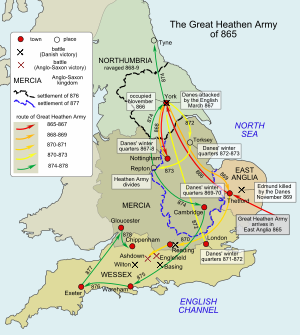 Global Information
Global InformationGreat Heathen Army information
| Great Heathen Army | |||||||
|---|---|---|---|---|---|---|---|
| Part of the Viking invasions of the British Isles | |||||||
 A map of the routes taken by the Great Heathen Army from 865 to 878 | |||||||
| |||||||
| Belligerents | |||||||
|
Vikings
|
Anglo-Saxon kingdoms:
Kingdom of Alba | ||||||
| Commanders and leaders | |||||||
|
Halfdan Ragnarsson Ivar the Boneless Ubba † Guthrum the Old Bagsecg † |
Æthelwulf of Wessex Æthelred of Wessex Alfred the Great Ælla of Northumbria † Osberht of Northumbria † Burgred of Mercia Edmund of East Anglia † | ||||||
| Strength | |||||||
| Unknown | Unknown | ||||||
The Great Heathen Army,[a] also known as the Viking Great Army,[1] was a coalition of Scandinavian warriors who invaded England in AD 865. Since the late 8th century, the Vikings[b] had been engaging in raids on centres of wealth, such as monasteries. The Great Heathen Army was much larger and aimed to conquer and occupy the four kingdoms of East Anglia, Northumbria, Mercia and Wessex.
The name Great Heathen Army is derived from the Anglo-Saxon Chronicle. The force was led by three of the five sons of the semi-legendary Ragnar Lodbrok, including Halfdan Ragnarsson, Ivar the Boneless and Ubba.[c] The campaign of invasion and conquest against the Anglo-Saxon kingdoms lasted 14 years. Surviving sources give no firm indication of its numbers, but it was described as amongst the largest forces of its kind.
The invaders initially landed in East Anglia, where the king provided them with horses for their campaign in return for peace. They spent the winter of 865–866 at Thetford, before marching north to capture York in November 866. York had been founded as the Roman legionary fortress of Eboracum and revived as the Anglo-Saxon trading port of Eoforwic. During 867, the army marched deep into Mercia and wintered in Nottingham. The Mercians agreed to terms with the Viking army, which moved back to York for the winter of 868–869. In 869, the Great Army returned to East Anglia, conquering it and killing its king. The army moved to winter quarters in Thetford.
In 871, the Vikings moved on to Wessex, where Alfred the Great paid them to leave. The army then marched to London to overwinter in 871–872. The following campaigning season the army first moved to York, where it gathered reinforcements. This force campaigned in northeastern Mercia, after which it spent the winter at Torksey, on the Trent close to the Humber.[1] The following campaigning season it seems to have subdued much of Mercia. Burgred, the king of Mercia, fled overseas and Coelwulf, described in the Anglo-Saxon Chronicle as "a foolish king's thegn" was imposed in his place. The army spent the following winter at Repton on the middle Trent, after which the army seems to have divided. One group seems to have returned to Northumbria, where they settled in the area, while another group seems to have turned to invade Wessex.[5]
By this time, only the kingdom of Wessex had not been conquered. In May of 878 Alfred the Great defeated the Vikings at the Battle of Edington, and a treaty was agreed whereby the Vikings were able to remain in control of much of northern and eastern England.
The Anglo-Saxon Chronicle does not mention the reason for this invasion, perhaps because Viking raids were fairly common during that period of time. The Tale of Ragnar's Sons,[6] on the other hand, mentions that the invasion of England by the Great Heathen Army was aimed at avenging the death of Ragnar Lodbrok, a legendary Viking ruler of Sweden and Denmark.[d] In the Viking saga, Ragnar is said to have conducted a raid on Northumbria during the reign of King Ælla. The Vikings were defeated and Ragnar was captured by the Northumbrians. Ælla then had Ragnar executed by throwing him into a pit of venomous snakes. When the sons of Ragnar received news of their father's death, they decided to avenge him.[7][8]
Cite error: There are <ref group=lower-alpha> tags or {{efn}} templates on this page, but the references will not show without a {{reflist|group=lower-alpha}} template or {{notelist}} template (see the help page).
- ^ a b Hadley. "The Winter Camp of the Viking Great Army, AD 872–3, Torksey, Lincolnshire", Antiquaries Journal. 96, pp. 23–67
- ^ Frantzen Anglo-Saxon Keywords. p 275
- ^ Friis-Jensen. The Making of Christian Myths in the Periphery of Latin Christendom (c. 1000–1300). p. 198
- ^ a b c Munch. Norse Mythology: Legends of Gods and Heroes, pp. 357–359.
- ^ Richards, Julian D.; et al. (2004). "Excavations at the Viking barrow cemetery at Heath Wood, Ingleby, Derbyshire" (PDF). The Antiquaries Journal. 84 (84): 23–116. doi:10.1017/S0003581500045819. S2CID 162404306. Archived (PDF) from the original on 2 October 2011.
- ^ Tunstall, Peter (2005). "The Saga of Ragnar Lodrok and his Sons Ragnars Saga Loðbrókar ok sona hans". germanicmythology.com. Retrieved 18 September 2021.
- ^ Kane. History of the Vikings and Norse Culture. pp. 72–74
- ^ Cite error: The named reference
jones219was invoked but never defined (see the help page).